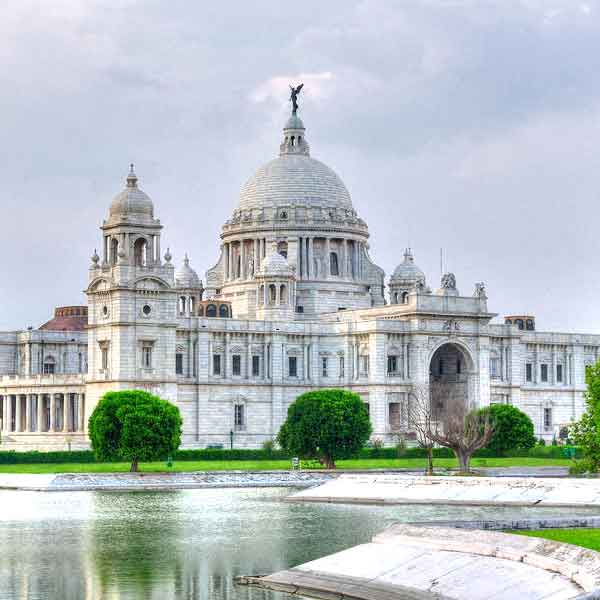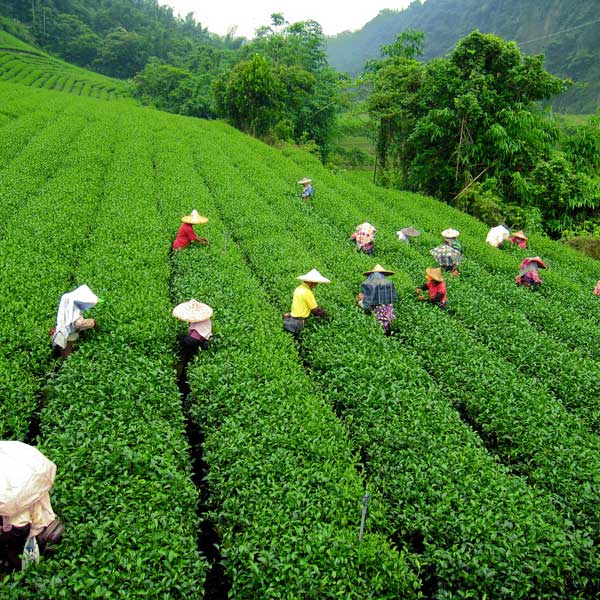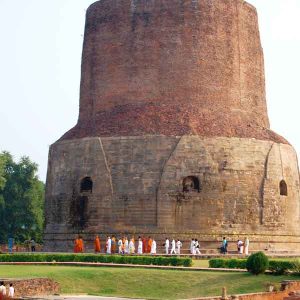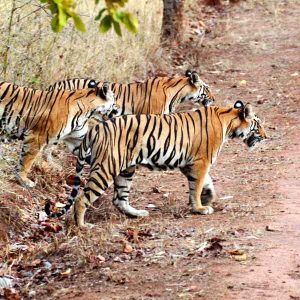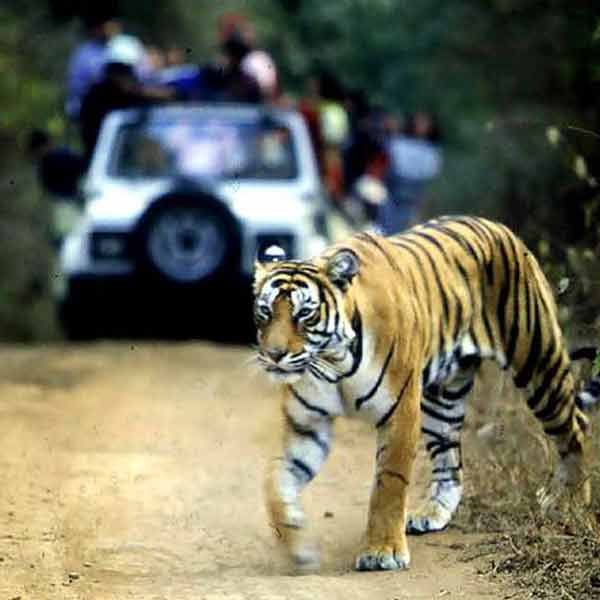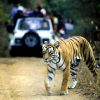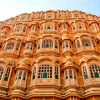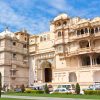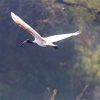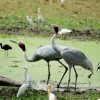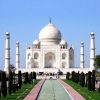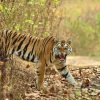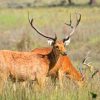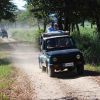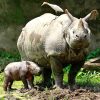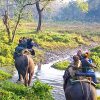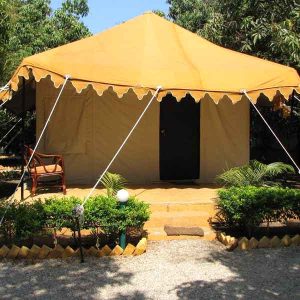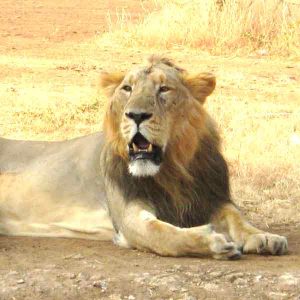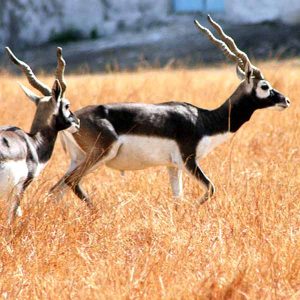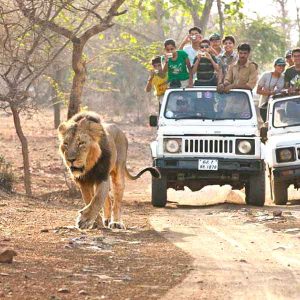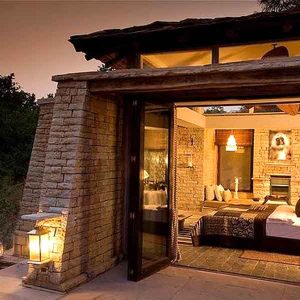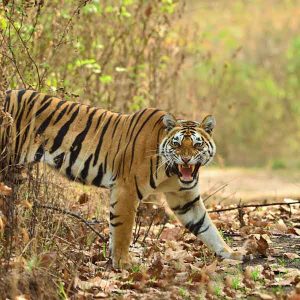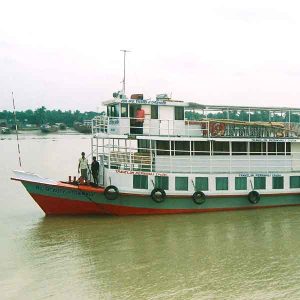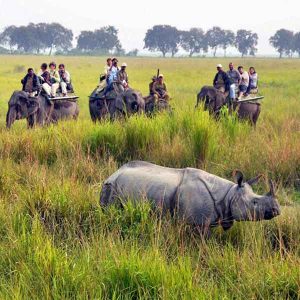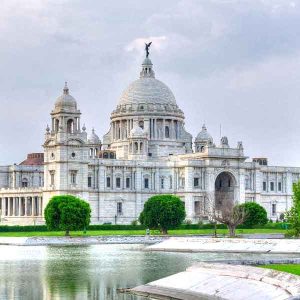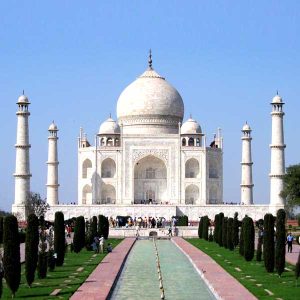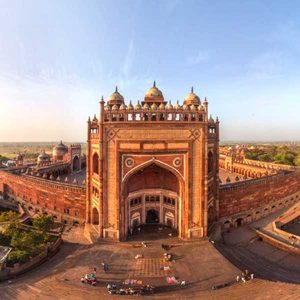Day 01: Arrive in Delhi.
Our representative will meet you outside the customs and immigration area at the airport. He or she will answer questions on the immediate arrangements and escort you to your hotel. If you arrive on a morning flight, you’ll take an afternoon sightseeing tour of Delhi, seat of power for Indian dynasties from the time of the Rajputs to the Moghuls to the British Raj. Overnight in Delhi.
Day 02: Delhi to Jaipur.
In the morning we’ll take a 40-minute flight to Jaipur. Jaipur is a rather young city by Rajasthan’s standards; it was founded in 1727 when Maharaja Jai Singh II moved his capital there. We’ll transfer to the hotel (which was formerly a royal palace), then enjoy a day of sightseeing. Jaipur is the ultimate showcase for Rajasthan’s distinctive architecture. Jai Singh II planned this city with great symmetry and wide spacious streets intersecting at right angles (unlike the narrow twisting streets of other cities of that era). In the old walled quarter of town, called the “Pink City” because of the soft suffusion of light that gives it a pink glow, there are glorious temples and palaces built in styles that span centuries.
Jaipur’s most famous building is the Hawa Mahal, or “palace of the winds.” Built in 1799, the palace has a five-story-high pink and white facade decorated with hundreds of windows, each covered by an ornately carved screen that allowed the women of Jai Singh II’s harem to be able to look out onto the street scene without being observed (they were in strict purdah). Other attractions include the City Palace, a magnificent building full of ornate marble gateways, delicate paintings, halls of public audience, courtyards, and gardens and still occupied in part by the royal family. Jai Singh II was a keen astronomer and he built a very unusual astronomical observatory called the Jantar Mantar. The instruments in this observatory are still used to calculate the Hindu astrological calendar, and the 90-foot-high sundial is accurate to within two minutes.
Outside of Jaipur, we’ll also visit the superb complex of forts and palaces at Amber, an old Rajput stronghold (which we ride to on elephant back!). Jaipur is lots of fun. Overnight in Jaipur.
Day 03: Jaipur to Ranthambore National Park.
In the morning, we’ll continue our visit to Jaipur, then have a four-hour drive through the countryside of Rajasthan en route to Ranthambhore. Along the way we pass through seasonally dry country that is used by the local people for growing wheat and raising cattle-but it is also a great place to encounter blackbuck in the wild. Many consider this graceful animal to be the most beautiful antelope in the world. It was once very abundant in northwestern India but has been eliminated from most of its range. Depending on the time of our arrival at Ranthambhore, we will probably have our first game drive in the national park this afternoon. Overnight in a Jungle Lodge in Ranthambore.
Days 04 to 06: Ranthambore National Park.
Ranthambhore is a magnificent park, studded with the crumbling remains of Rajput and Moghul buildings now overgrown by the jungle. The most captivating are the ruins of the 700-year-old Ranthambhore Fort-in which tigers, leopards, and monkeys often take refuge.
Ranthambhore park preserves a big tract of open dry-deciduous forest, the “jungle” of western India. A good population of tiger lives here (the park is well known for its daylight sightings), as well as leopard, sloth bear, striped hyena, and other smaller carnivores. The common prey species include the large and shaggy sambar deer, chinkara (the Indian gazelle, smallest of India’s antelopes), nilgai or blue bull (largest of the Indian antelopes), the beautifully spotted chital deer, wild pig, and silver langur monkey. Grassland areas and small lakes dot the park, so bird life is plentiful and varied, including wild peacock, painted sand grouse, jungle fowl, and myriad woodland birds. Some of Ranthambhore’s lakes are habitat for the fearsome Indian mugger, the marsh crocodile.
While at Ranthambhore, we’ll do our game viewing by vehicle on morning and evening game drives. Park regulations restrict the number of vehicles allowed in the park at any one time and limit the duration of game drives to no more than three hours each to protect the wildlife from over-disturbance. During our midday hours, we’ll have ample time to bird-watch in several different habitats, and to visit the active Hindu temple of Ganesh (the elephant-headed god of prosperity) that is located within the towering ramparts of the Ranthambhore Fort. We’ll also get to see and meet the colorful people of Rajasthan, who wear turbans and graceful saris, as they tend their fields and ride their camel-drawn carts.
Day 07: Ranthambore to Keoladeo Ghana National Park, Bharatpur.
We take an early morning train to Bharatpur, arriving about 9:30 a.m. We then transfer to our lodge where we relax before visiting Keoladeo Ghana National Park. Keoladeo is a beautiful reserve, dotted with lakes and waterways built by the Maharajah of Bharatpur when the park was his private bird hunting preserve. It was later turned into a national park, and is such an important place for migratory birds that it has been declared a World Heritage Site.
We’ll have the whole afternoon to investigate this world-famous nature reserve. Named for the Shiva temple located at its center, Keoladeo is one of the finest bird sanctuaries in the world, harboring over 360 species. It is also well known as the wintering ground for countless thousands of migratory Eurasian waterfowl, and especially for the highly endangered Siberian crane. Although many of these migrants may be absent when we visit, a fabulous collection of colorful water birds will undoubtedly be here. These include painted stork, sarus crane, white ibis, Asian open-bill stork, spoonbill, and a variety of moorhens and jacanas, as well as egrets, herons, pelicans, and cormorants. Woodland species (such as paradise flycatchers, kingfishers, bee-eaters, rose-ringed parakeets, and doves) are all abundant residents, and many will be starting their nesting behaviors.
The most common large mammals include wild pig, nilgai, chital, and sambar. In 2001, a wild tigress took up residence in the park! Although we are most unlikely to see this shy individual, we will probably see smaller carnivores. The celebrated Indian mongoose is abundant, and there is a good possibility of encountering interesting small carnivores such as the jungle cat, smooth-coated otter, and the unusual fishing cat. Monitor lizards and the beautiful Indian python, one of the longest snakes in the world, are commonly seen. We explore the wetlands by foot and bicycle rickshaw on a network of trails and dikes, as well as by boat (if water levels are sufficiently high). We may also be able take a walk at night (outside the park) looking for nocturnal creatures such as the porcupine, jackal, and toddy cat. Overnight in a Jungle Lodge in Bharatpur.
Day 08: Bharatpur to Agra via Fatehpur Sikri.
We have an early morning of explorations in the Keoladeo park. A two-hour drive then takes us to Agra, and we’ll stop along the way to visit the deserted city of Fatehpur Sikri (“the city of victory”). Built by the Moghul Emperor Akbar, Fatehpur Sikri is a walled Indian “ghost town” of elaborate royal audience halls, palaces, and mosques that are perfectly preserved and faithfully record the ambiance of its time. We continue to Agra, famous the world over as the city of the Taj Mahal. One of the greatest architectural masterpieces of the world, the Taj was built by Emperor Shah Jehan in memory of his beloved consort, Mumtaz Mahal. The mausoleum and its compound are built of gleaming marble inlaid with semiprecious stones. It’s an incredible sight at any time, but especially in the golden light of sundown and sunrise, or in moonlight. We will visit the Taj this afternoon, or early the next morning.
While in Agra, we’ll also tour the famous Agra Fort. Built by the Emperor Akbar, its maze of courtyards, mosques, and private chambers tell the story of the Moghul Empire. Such monuments as the Moti Masjid, the Jasmine Tower, and Itmad-ud-Daulah reflect the skills of this era’s Indian architects and artists. Overnight in Agra.
Day 09: Agra to Delhi.
After finishing our tour of Agra’s monuments, we’ll make a five-hour drive to Delhi. On the way, we stop at Sikandra, the tomb of the Mogul Emperor Akbar, where the grounds contain a resident herd of regal blackbuck antelope. We’ll also stop for lunch on the way to Delhi. Overnight in Delhi.
Day 10: Delhi to Kanha National Park via Nagpur.
We take a morning flight to Nagpur in central India. We then drive about six hours through the rural countryside of Madya Pradesh, absorbing some of the color and vitality of life in contemporary India as we go. We’ll pass fascinating markets and bustling Hindu temples, and can stop to investigate whenever we want. Villages and farms gradually give way to the forests of India’s central highlands as we near Kanha National Park. In the afternoon, we arrive at our hotel in the buffer zone along the boundary of Kanha National Park, where we can take a bird walk along the lovely Banjar River. If we arrive in good time, we will have a game drive in the park this afternoon. Overnight in a renowned Jungle Resort in Kanha.
Days 11 to 13: Kanha National Park.
Kanha is probably the best wildlife reserve in all Asia for viewing tigers. Situated in the eastern sector of India’s central highlands, it covers over 940 sq. km. in the Maikal range of hills (a Buffer Zone brings the total protected area up to 1,945 sq. km.). The reserve is managed as part of Project Tiger, an internationally supported program for tiger conservation. Kanha has a large, healthy population of tigers (reputed to number over 100), and they are often seen abroad during the day. But this park features more than tigers; it supports the full range of Indian wildlife described by Rudyard Kipling in The Jungle Book (the Kanha region is reputedly the setting for that famous story). And what a setting it is: river valleys cut through wooded, bamboo-covered hills; in the valleys, large grassy meadows called maidans intersperse with stands of evergreen sal forest to form a savanna countryside reminiscent of Africa.
The variety and abundance of wildlife in Kanha is remarkable. The park is famous for its herds of hard-ground Barasingha-also called swamp deer, a large and beautiful endemic animal with 12-point antlers (it has probably been saved from extinction by careful management in Kanha). Also found are herds of the beautiful chital (also called the spotted deer), and sambar, the biggest of the Indian deer. Other commonly seen herbivores include barking deer, nilgai antelope, four-horned antelope, wild boar, and the imposing gaur (also called the Indian bison), which is considered the largest wild bovine in the world. A gaur bull can stand over six feet tall at the shoulder and weigh more than a ton! Kanha is known for its large population of gaur, and this large animal is an important food source for the tiger.
Predators in the park include sloth bear, the common (or golden) jackal, the striped hyena, and the dhole or Indian wild dog (which, like the African wild dog, lives and hunts in packs). Leopards also live in Kanha, and although more easily overlooked than the tiger, they are regularly seen here. Other interesting mammals include the Indian ratel (honey badger), Indian porcupine, and various species of mongooses. Primates are represented by troops of monkeys of two species-the rhesus macaque and the silver (or common) langur. Kanha’s bird life is equally impressive, with more than 200 recorded species.
We’ll spend three full days at Kanha, where we explore by four-wheel-drive vehicles and by elephant-back on morning and afternoon excursions in the park. Walking is not allowed within the national park, but we’ll be able to do bird walks in the buffer zone forests outside the park. We’ll try to attend the daily bath of the park’s elephants in the Banjar River on at least one occasion.
Day 15: Nagpur to Delhi.
We take a morning flight to Delhi. In the afternoon, we’ll visit the Delhi Zoo, which has an excellent collection of Indian wildlife. We’ll get up-close viewing of the animals we’ve been seeing in the wild, as well as sightings of some of the rare or nocturnal creatures that may elude us. Overnight in Delhi.
Day 16: Delhi to Kaziranga National Park via Gauhati.
Transfer to the airport and fly to Gauhati in Assam, in northeast India. Assam is lovely, lush, and semi-tropical: the culture and environment share some affinities with those of neighboring Burma and offer a remarkable contrast to those of Rajasthan and Madya Pradesh. We drive about five hours through a charming countryside of tea estates to Kaziranga National Park, arriving in the late afternoon. Check into a Forest Lodge for 4 nights.
Days 17 to 19: Kaziranga National Park.
Kaziranga is one of the world’s key wildlife sanctuaries. It protects one of the few remaining regions of natural habitat in the terai, the lowland valleys in the foothills of the mighty Himalaya. Since it is located on the floodplains of the Brahmaputra River, Kaziranga is seasonally flooded by monsoon rains and floods carried down by the great river. The park is characterized by “grass jungle” in which floodplains of tall elephant grass intersperse with tracts of tropical forest. Numerous marshes and oxbow lakes dot the floodplains. It is exceptionally rich wildlife habitat.
The park (which is 430 sq. km. in area) is the stronghold of the great Indian one-horned rhinoceros, with a population of more than 1,100. Two other giant (and highly endangered) mammals also find sanctuary in Kaziranga: the Asian elephant and the wild water buffalo. The latter, a formidable beast, should not be confused with its cousin, the domesticated water buffalo; the wild species has a spread of horns wider than that of the African buffalo, and it is equally aggressive.
The Asian elephant is, of course, as fascinating as the African species, and we can compare and contrast the similarities and differences between them. Observations of wild elephants are particularly good here, especially when they come down to jungle-fringed lagoons to drink and bathe. Tiger, sloth bear, sambar, swamp deer, hog deer, smooth-coated Indian otter, both jungle and fishing cats, and a variety of other mammals live here, too.
Assam macaques and capped langurs are the local monkeys at Kaziranga, while incredibly acrobatic hoolock gibbons, India’s only ape, can be seen in the hill forests of the neighboring Panbari Reserve Forest. Gangetic dolphins cruise the Brahmaputra River, and thousands of water birds, such as pelicans and storks, flock around Kaziranga’s small lakes. Its hardwood jungles are home to many spectacular birds such as the great Indian hornbill, the hill myna, and the blue-bearded bee-eater.
Wildlife watching in Kaziranga is truly spectacular. We always get numerous sightings of rhinos and elephants and get to see them indulging in a variety of behaviors and interactive social situations. We spend three days rambling around Kaziranga’s marshes and grassy plains, doing our game viewing by vehicle and also while riding on the back of trained elephants, a great way to get close to wild animals and view them from a high perch. If conditions permit, energetic hikers can undertake a hike in the Panburi Forest to search for gibbons, capped langurs, and birds (this is a rough hike in hilly forest without any real trails, and is only available subject to the permission of park authorities).
Day 20: Kaziranga to Delhi. Depart Delhi.
Drive to Gauhati and fly to Delhi in the early afternoon, arriving in Delhi by 5:00 p.m. Transfer to the hotel to freshen up and prepare for evening flights. We’ll have a farewell dinner, then transfer to the airport for departure on homeward bound flights.
Date and price to suit individual arrangements based on 2 people sharing. Breakfast included. Private air-conditioned car and driver with English speaking guides for sightseeing.

